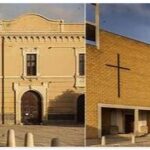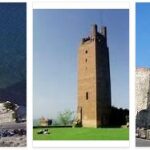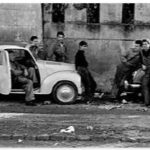Italy Federiciana Part 7
However, the formation of these composite political groups, the persistence of an upward social mobility, the permeability between classes, the establishment of a form of government that was not an immediate expression of social pre-eminence, the rhetoric of the supremacy of public affairs and of the necessary coexistence and compatibility between maiores and minores, milites and pedites, nobiles and populares, the pacification movements, partly promoted in a new religious fervor of the laity (above all by the movement of Francis of Assisi and of the Minors), all this did not eliminate the fundamental contrast between noble and non-noble components: from the end of the 1920s The thirteenth century, that is, from the time of the resumption of the conflict between Frederick II and the papacy, and then in the years of the succession of pacifications and bellicose revivals and the definitive crystallization of the Ghibelline-Guelph clash, the internal conflict in the cities took on new connotations, and of greater harshness, compared to the time we have defined podestarile-council. According to Itypeauto, the confrontation between the military-noble component and the popular one took on the character of a confrontation between political parties, partes. This implied, among other things, the wide participation of aristocratic characters in popular movements, also with the function of leaders and guides of the same, and conversely the confluence of popular elements in the aristocratic partes. Precisely because of this tendency towards the constitution of the classes in political partes, the merchant and artisan elites of the cities created a structure such as the populus, in the form of a political body parallel to the municipal body, with the authority of its own captain and with its own regulatory activity and its own economic and financial management.
When the Guelph-Ghibelline conflict and the transversal division into partes of cities and families began, the structures, tools and culture were already in place.capable of transforming a dialectic of compatibility into a clash, much less reducible, between political organisms defined as such and not led by certain formations of social classes. The conflict between the emperor and the Apostolic See and their respective supporters contributed in a very relevant way to this evolution of the political dialectic, which from a dialectic of coexistence and compatibility evolved towards one of the overwhelming type, to a physiognomy of political struggle as a struggle for the definitive and non-returnable exclusion of one of the two parties. In turn, this intertwining between the evolution of the clash that opposed the powers of universal ambition to each other and the evolution of the internal political structure of the cities was grounded in a new phase of economic and social transformation, and mutually gave impetus to it. Even if it has not yet been clearly clarified through very analytical studies and necessary comparisons, the epoch of the central decades of the thirteenth century seems to be able to be read without a doubt in the sign of a slowdown (not of interruption, but, it is worth repeating, of slowing down) of the processes the formation of wealth and the rise of social classes towards city government ambitions. Careful research has shown how the families that appear dominant in the cities starting from the mid-thirteenth century are overwhelmingly families already established in the period around 1180-1220, and how the number of new accessions to the dominant strata is much more modest. In short, there was a process of selection, of concentration of powers and wealth, of growing social divergence, partes. In the forms of ascent to power, those who had already long been on the political stage and those who could count on that confluence of land accumulation, of wealth deriving from financial and commercial profits, from intervention in the financing of public debt, from intervention in the financing of public debt, from intervention in the financing of public debt, were found increasingly privileged. assuming institutional roles in political and ecclesiastical careers, in the cardinalate and in new religious orders, roles that were less and less within the reach of new classes and classes of rural formation. It thus happened that the populus with which the papal Curia entered into agreements, and with which it found support in the conflict with the emperor, was something different from the populus. from the end of the XII century. and of the early thirteenth century that the papacy had considered with fundamental hostility. At the same time, a more selective and more powerful nobility was forming than the milites of the podestarile and council age. The problem of the milites evolved into the problem of the magnates, of the great ones, of the families of very limited numbers which, due to their excessive economic and social power, could be destabilizing for the quiet conduct of the political life of the city: this all the more serious the more the conflict was ignited. of partes and thus formed coalitions hegemonized by powerful and opposing family clans.
From the phase of fundamental homogeneity of institutional outcomes of the years from 1180 to about 1220 we thus passed to the phase of diversity and a new geography of political Italy. Some aspects of state construction were actually widely common. Everywhere the legislative arrangements intensified, the provisions dictated by the needs of the internal order and a regular administration of criminal justice, the efforts for acceptable definitions of the contributory capacities of the residents, and wherever forms of government intermediate between podestà and council were tested, with the establishment of bodies with large executive power, of a collegial nature: restricted councils, colleges of the elderly, colleges of twelve, twenty-four, thirty-six. But the weight to be attributed to the different social components in these organisms, with the mechanisms of seat reserves and exclusions, they marked a differentiating factor from city to city. The rest was the result of the struggle between the greatspolitical partes and between city factions, and of the weight that eminent families exercised in public life. Thus we moved towards the basic differentiation between large governments, oligarchies and aristocratic regimes, but neither does it summarize the variety of situations.
In this variety, the weight of the aristocratic component in the municipal cities always appears great. It grew even more in other political formations and gave some of them the fundamental imprint: so in the Kingdom, so in many noble and feudal articulations, so in the dynastic and ecclesiastical principalities, such as the patriarchate of Aquileia in the north-east of Italy and, in the North-West, the marquisate of Monferrato, to mention only the two major groups at the time of Frederick II. In all these political structures the aristocratic classes knew complex and very different articulations, depending on the origin from more or less ancient stocks of milites and of local lords and according to the relationship with the prince: feudal dependence, official investiture, mixture of the two moments. Important developments in the aristocratic classes were those of ministeriality, that is a relationship of close subordination and with almost servile aspects towards the prince and at the same time with great prospects of political power in the court, and those of the presence in parliaments, bodies with judicial and tax groups set up for variously represented classes (nobles, churches, city communities). In this context of complexity, articulation and mobility, it is idle to pose the question of the relationship between Emperor Frederick II and the nobility in general terms, and instead it is necessary to consider situation by situation, political territory by political territor.











